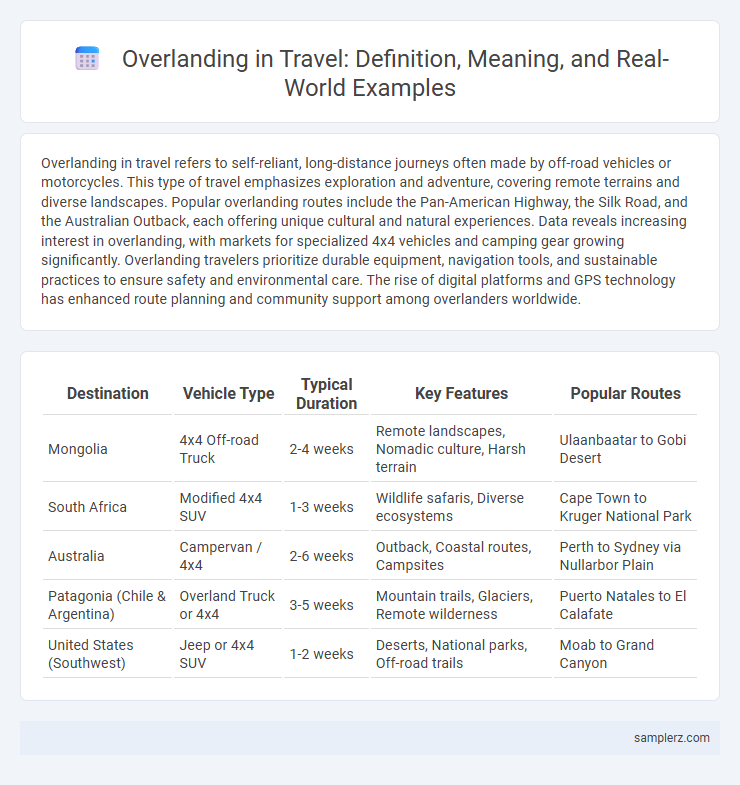Overlanding in travel refers to self-reliant, long-distance journeys often made by off-road vehicles or motorcycles. This type of travel emphasizes exploration and adventure, covering remote terrains and diverse landscapes. Popular overlanding routes include the Pan-American Highway, the Silk Road, and the Australian Outback, each offering unique cultural and natural experiences. Data reveals increasing interest in overlanding, with markets for specialized 4x4 vehicles and camping gear growing significantly. Overlanding travelers prioritize durable equipment, navigation tools, and sustainable practices to ensure safety and environmental care. The rise of digital platforms and GPS technology has enhanced route planning and community support among overlanders worldwide.
Table of Comparison
| Destination | Vehicle Type | Typical Duration | Key Features | Popular Routes |
|---|---|---|---|---|
| Mongolia | 4x4 Off-road Truck | 2-4 weeks | Remote landscapes, Nomadic culture, Harsh terrain | Ulaanbaatar to Gobi Desert |
| South Africa | Modified 4x4 SUV | 1-3 weeks | Wildlife safaris, Diverse ecosystems | Cape Town to Kruger National Park |
| Australia | Campervan / 4x4 | 2-6 weeks | Outback, Coastal routes, Campsites | Perth to Sydney via Nullarbor Plain |
| Patagonia (Chile & Argentina) | Overland Truck or 4x4 | 3-5 weeks | Mountain trails, Glaciers, Remote wilderness | Puerto Natales to El Calafate |
| United States (Southwest) | Jeep or 4x4 SUV | 1-2 weeks | Deserts, National parks, Off-road trails | Moab to Grand Canyon |
Understanding Overlanding: A New Era of Adventure Travel
Overlanding redefines adventure travel by combining self-reliant off-road driving with immersive cultural exploration, often using specially equipped vehicles designed for extended journeys across diverse terrains. This mode of travel emphasizes slow, sustainable movement through remote landscapes, allowing travelers to engage deeply with local environments and communities. Popular overlanding routes include the Pan-American Highway, the Silk Road, and the Australian Outback, where travelers experience unparalleled freedom and discovery.
Essential Gear for Overlanding Journeys
Essential gear for overlanding journeys includes durable rooftop tents with waterproof materials, portable dual-battery systems to power electronics, and high-capacity water filtration units to ensure safe drinking water in remote locations. Reliable all-terrain tires and recovery equipment like winches and tow straps are critical for navigating challenging terrains and self-recovery during off-road travel. Lightweight cooking systems, solar panels, and comprehensive first aid kits enhance safety and self-sufficiency on extended overlanding expeditions.
Popular Overlanding Routes Around the World
The Pan-American Highway spans nearly 19,000 miles from Alaska to Argentina, offering diverse landscapes for overlanding enthusiasts. The Silk Road route through Central Asia combines historical exploration with rugged terrain challenges. Australia's Canning Stock Route, stretching over 1,800 miles across remote Outback, remains a favorite for adventure travelers seeking solitude and extreme conditions.
Iconic Overlanding Destinations to Explore
Explore the vast landscapes of the Australian Outback, where rugged terrains and remote wilderness provide a classic overlanding experience. Traverse the Pan-American Highway stretching from Alaska to Argentina, offering diverse ecosystems and cultural encounters across the Americas. Discover the diverse beauty of the Sahara Desert routes, combining challenging off-road driving with unique desert culture and history.
Real-Life Overlanding Stories and Experiences
Travelers exploring Patagonia share vivid real-life overlanding stories, highlighting rugged terrain challenges and breathtaking landscapes encountered on extended 4x4 expeditions. Families embarking on Southeast Asia overlanding trips recount cultural exchanges and remote village stays, emphasizing authentic local interactions and self-sufficient travel. Enthusiasts traversing Australia's Outback detail mechanical troubleshooting and wildlife encounters, illustrating the unpredictable nature and rewarding solitude of overland adventures.
Planning Your First Overlanding Trip: Step-by-Step
Planning your first overlanding trip involves selecting a suitable vehicle equipped for rugged terrains, such as a 4x4 with roof racks and camping gear. Map out your route using GPS and topographic maps, prioritizing remote locations with accessible water sources and established campsites. Prepare essential supplies including recovery tools, food, water, and communication devices to ensure safety and self-sufficiency throughout your adventure.
Challenges and Rewards of Overlanding Travel
Overlanding travel presents challenges such as navigating remote terrains, managing vehicle maintenance in isolated areas, and coping with unpredictable weather conditions. These obstacles demand thorough preparation, self-reliance, and adaptability from travelers. Rewards include unparalleled cultural immersion, access to off-the-beaten-path destinations, and the freedom to explore diverse landscapes at one's own pace.
Top Vehicles for Overlanding Adventures
Toyota Land Cruiser, Jeep Wrangler, and Land Rover Defender are top vehicles for overlanding adventures due to their durability, off-road capabilities, and reliability in remote terrains. These vehicles offer essential features like four-wheel drive, high ground clearance, and ample storage space for extended travel. Equipped with rugged tires, roof racks, and customizable interiors, they ensure comfort and efficiency for long-distance exploration.
Eco-Friendly Practices in Overlanding
Overlanding trips in regions like Patagonia employ solar-powered camping gear and portable water filtration systems to minimize environmental impact. Travelers use biodegradable soaps and adhere to Leave No Trace principles, ensuring minimal disruption to local ecosystems. Wildlife-friendly route planning and avoiding sensitive habitats enhance conservation efforts throughout the journey.
Tips for Staying Safe While Overlanding
Staying safe while overlanding requires thorough vehicle maintenance checks before departure, including tire pressure, fluid levels, and emergency equipment readiness. Carrying reliable navigation tools such as GPS devices, physical maps, and a satellite communicator ensures consistent connectivity in remote areas. Always inform trusted contacts of your itinerary and expected check-in times to facilitate timely assistance in case of emergencies.

example of overlanding in travel Infographic
 samplerz.com
samplerz.com